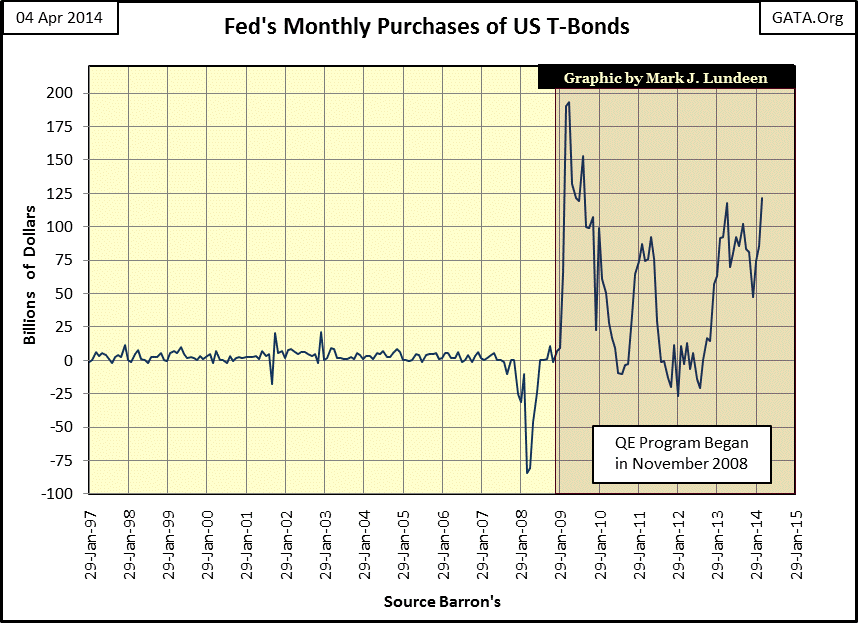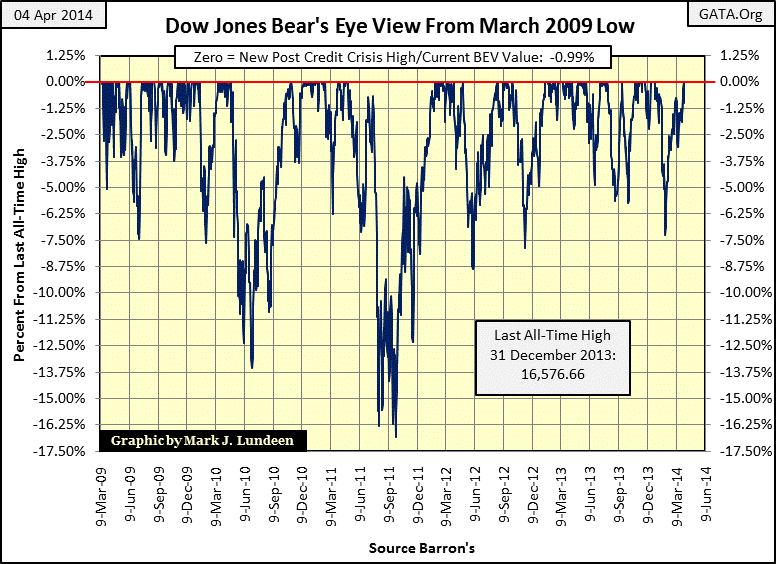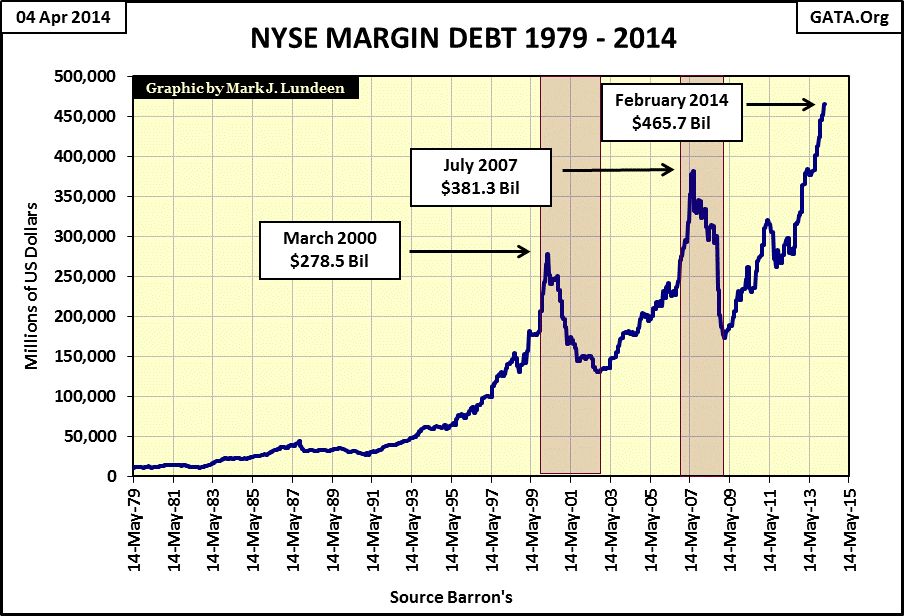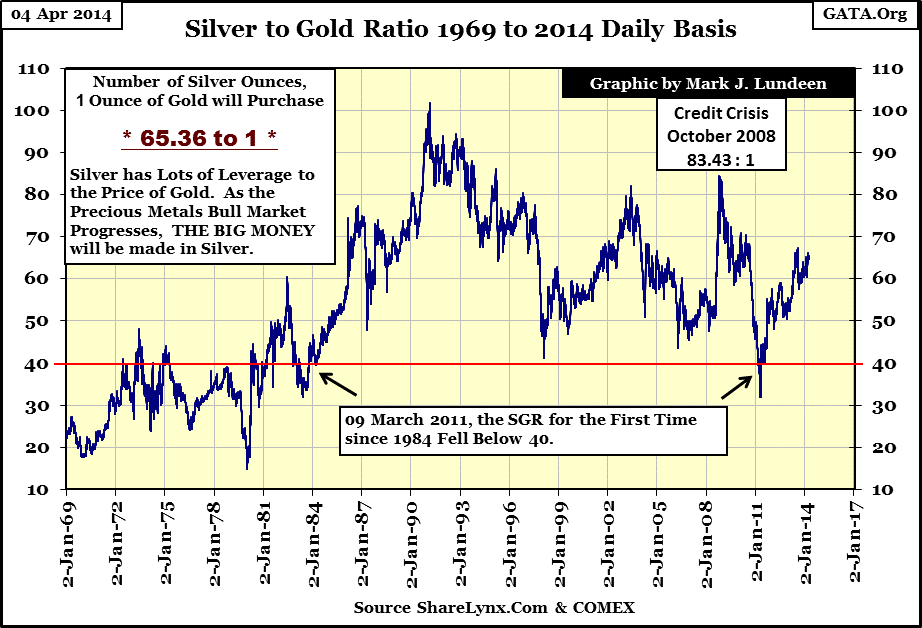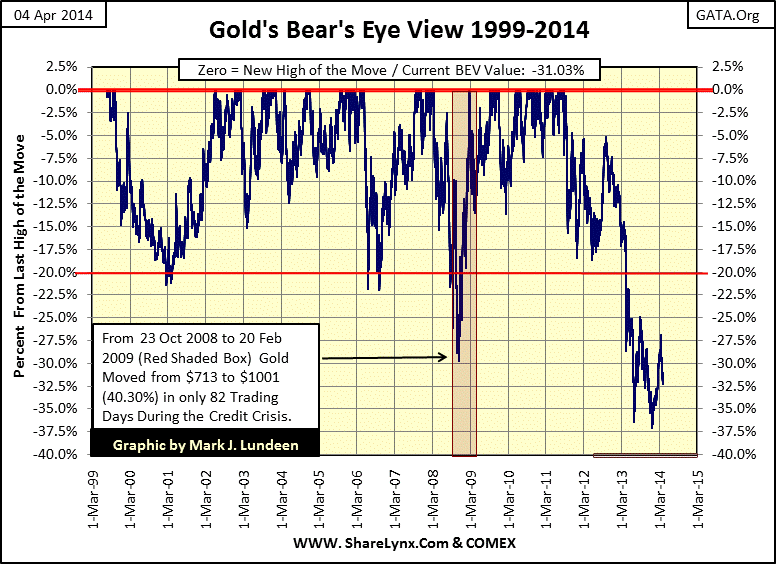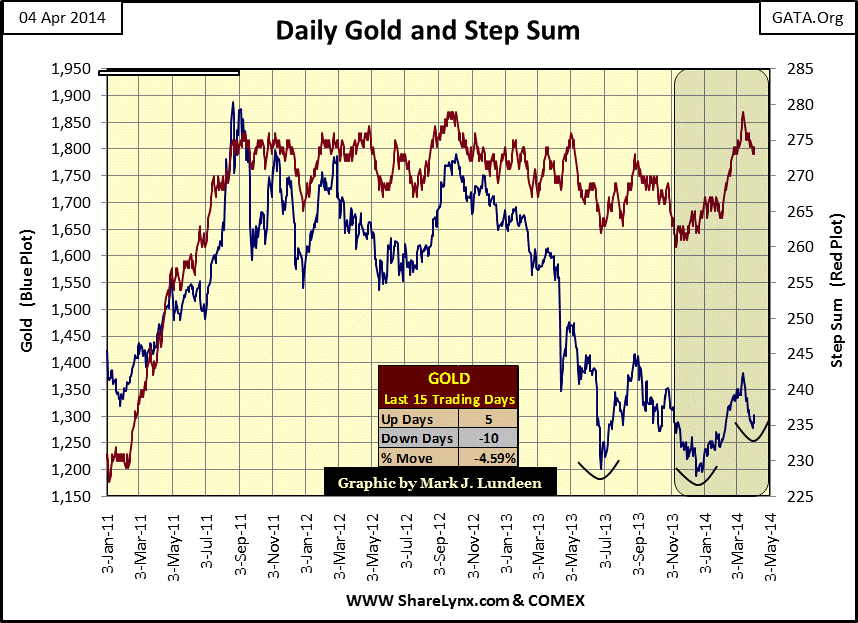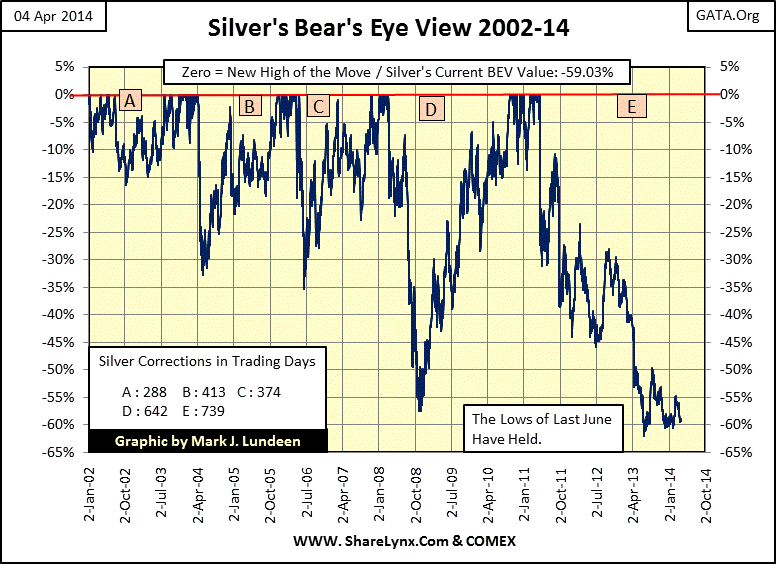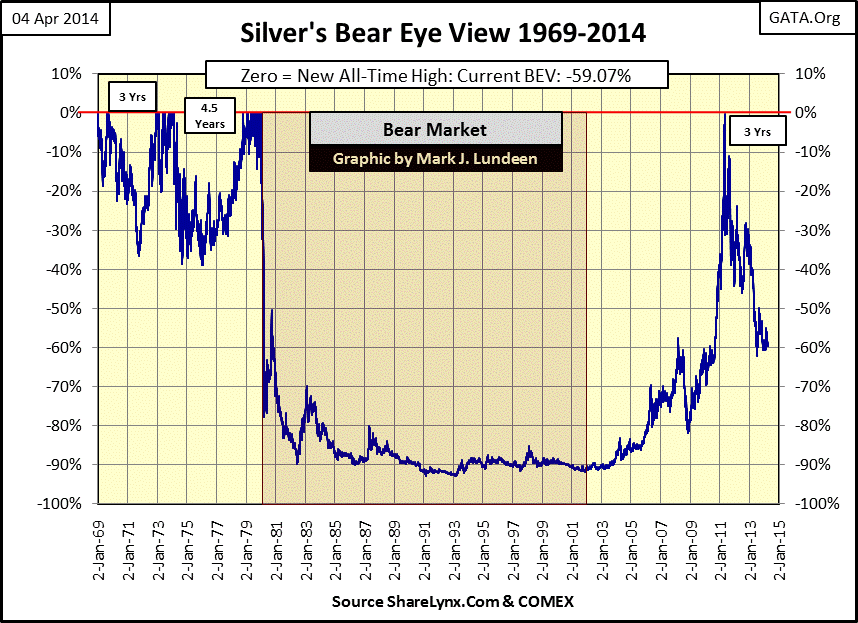Tapering QE: And Then Some!
QE-3 began in September 2012 with the Federal Reserve committing itself to the purchase of $85 billion dollars a month of US Treasury bonds and illiquid mortgages from its favorite financial institutions – the big NY banks. And why not? They own the Federal Reserve. In December the Fed announced they were going to reduce their QE by $10 billion in January, and then announced they would taper QE by $10 billion in February and another $10 billion in March. No doubt they will be “tapering” QE by another $10 billion in April as they have also said that they want to be out of the QE business by autumn of this year.
Being the curious sort, I made a chart showing the Federal Reserve’s monthly purchases of US Treasury debt going back to January 1997. Remember, these are just the Federal Reserve US T-Bond purchases. I don’t have any data on the non-performing mortgages (Fannie/Freddie bonds) purchased by the Fed.
From 1997 to 2006 we see Alan Greenspan’s bubble-blowing monetary program in the chart below, which typically increased the Federal Reserve’s balance sheet by less than $10 billion a month, even during the housing bubble. The housing bubble can be seen bursting as the plot declined by $10 billion in September 2007, when the Federal Reserve began swapping its T-bonds for Wall Street’s illiquid mortgages. By summer of 2008 the chairman of the House Committee on Financial Services; Barney Frank (D-Mass) in a televised interview expressed his concerns that the Fed was running out of US T-bonds and may need the assistance of the US Treasury in their effort to maintain “stability” in the banking system.
What happened? The NY Banks’ interest rate derivatives (insurance policies) were coming into the money as the mortgage market became illiquid, an event that Wall Street had neglected to make provisions for by maintaining adequate reserves. This was, and is a multi-hundred trillion dollar market, a market from which Wall Street had just collected income and then squandered the revenues on employee bonuses as government regulators looked on in silence. This is still the case, as nothing has changed since 2008. The grotesque monthly purchases since September 2008 have been the Federal Reserve’s response to Wall Street’s interest-rate derivative swindle.
The first QE began in November 2008, a “new tool” given by Congress to the Federal Reserve to slay the dragon of deflation in the financial markets. The charts above and below tell the tale; after October 2008, “monetary policy” became an act of desperation and any talk of “tapering” QE is just talk.
Here’s a table listing the monthly changes in the Federal Reserve’s holdings of US Treasury bonds. From September to December we were told that QE was purchasing $85 billion in US T-bonds and non-performing mortgages each month, and then starting in January to March, the Fed was cutting their QE purchases by $10 billion a month. However this just isn’t true as per the Fed’s own balance sheet.
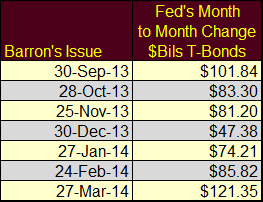
As academics, members of the Federal Reserve no doubt have a good answer for this rather large discrepancy between their public announcements of tapering and what they actually did with their purchases of US Treasury bonds. Maybe that QE was in addition to some as yet unannounced program of monetizing the national debt. “Sure we reduced QE by $10 billion each month since December, but we had to increase our newly scheduled secret monetization by $100s of billions since the first of the year.” As a member of the public the thought has occurred to me that “monetary policy” is being conducted by ethically challenged scoundrels working against the public’s interest for the benefit of the banking elite; but as a consumer of financial news, what do I know? I do know that since 2007, “monetary policy” has been out of whack and none of the Ph.Ds. managing the Federal Reserve know how to restore it without blowing up global financial markets in the process.
One more thing we know for sure; the stock market is acting as if the Federal Reserve has not yet begun any reduction in its QE program. On Thursday of this week the Dow Jones was only 0.02% (3.66 points) from making a new all-time high.
Here is an alarming chart; NYSE margin debt is at a new all-time high just as it was in 2000 and 2007. Now, again in 2014 retail investors are borrowing money to leverage their profits, (or more likely their future losses). Although, I don’t see this as a sign of impending doom for the stock market, the gains since the market bottom in March 2009 have been very generous to the bulls. Reasonable people should understand that whatever gains are still to be had in the stock market’s current run-up, the best is behind us now, meaning there is more risk than reward in the months and (maybe years) to come.
This chart also tells us how easily the Federal Reserve System can create debt and a false pretense of prosperity as it does so. NYSE margin debt peaked at 6.8 billion dollars in October 1929, a sum of margin debt not exceeded until four decades later in 1968. Realize also that brokers can lead their clients to margin debt, but they can’t make them fill out the paper work for a margin account. Here’s the major reason for the four decades separating the 6.8 billion dollar peaks in margin debt; retail investors’ * FEAR * of leverage after the Roaring 1920s stock market and the Great Depression bear market.
Compare the growth in margin debt from 1929 to 1968 with contemporary retail investors’ appetite for leveraged bets in the stock market in the chart above; since 2000 it only takes seven years for margin debt levels to recover before going on to new all-time highs. Like Rambo, today’s retail investors can take a bullet and keep going! If Fed Chairwoman Yellen continues “tapering” the Federal Reserve QE as she has since the beginning of the year, we may see the Dow Jones well above 18,000 by the end of the year. The market bulls gleefully taking on margin debt certainly believe that could be the case; but I’m not so sure.
Here is the Silver to Gold Ratio (SGR). Currently it’s at 65.36 ounces (4 pounds) of silver to 1 ounce of gold. That makes silver a highly leveraged play on the rising price of gold.
So when will the price of gold rise? I don’t know when, only that gold will eventually go on to prices most people today would find shocking for the reasons seen in this article’s first two charts. However, right now the price of gold is in the dumps; 31.03% below its highs of August 2011 as shown in the BEV chart below. However, as we see in its red box, from Oct 2008 to Feb 2009 gold went from 30% below its last all-time high to a new all-time high as the credit crisis peaked. So when the gold market eventually decides to make a move, it could be only a few months away from taking out its last all-time high of $1888 high seen on 22 August 2011.
I expect a similar resolution to gold’s current correction; but the problem we gold bulls have is that all the major players in the market currently want low gold prices. That is true with the Western banking system, the people who manage the paper-gold futures market. Low gold prices make their paper currencies and debt more attractive in the global financial market. Then there are the Asian central bankers who are aggressively buying every last ounce of actual gold bullion they can lay their hands on to ship back to Asia. And why are they doing that? Asian bankers follow trends in the Federal Reserve’s balance sheet too. Look at the date in the quote below, and check it out on my Fed’s Monthly Purchases charts above (first two charts).
“We hate you guys. Once you start issuing $1 trillion-$2 trillion [$1,000bn-$2,000bn] . . .we know the dollar is going to depreciate, so we hate you guys but there is nothing much we can do.”
- Luo Ping, a director-general at the China Banking Regulatory Commission , 11 February 2009
For good reasons China is exchanging as many dollars as they can for gold. But like buyers everywhere, they like buying low. So don’t expect them to do anything to force the price of gold higher as long as they can continue purchasing tons of it on the cheap, courtesy of the Western banking system.
Here’s gold’s step sum chart. Market sentiment (as seen by the step sum’s Red Plot) turned downward with gold’s price trend in mid-March. Not much to say about that, except to note gold’s price trend seems to be forming a “W” shaped head and shoulder bottom. This could be the start of something big, but currently the “policy makers” in the paper futures markets are still in control. Unless something exciting happens, like a rapid $200 spike in the price of gold, there isn’t much that would get me excited in the gold market. Don’t worry, eventually this moribund market will turn around and go on to exciting new highs. Maybe the thing to do is sell your stocks in the next few months to retail investors buying on margin, and buy some gold and silver while the “policy makers” are still able to keep prices depressed.
The silver market is depressing. But looking at the downside risk, silver now 60% below its April 2011 highs is a much better risk than the stock market near its all-time high.
Still, in the past three years silver has seen one horrible price correction. Here’s a 1969-2014 BEV chart showing silver’s corrections during two bull markets. Amazingly, silver’s last all-time high is still from January 1980; whoever heard of a bull market that failed to developed a new all-time high it could call its own? So far that is the case for the 2002-2014 bull market in silver. Silver’s BEV -60% line has been the support level since last summer. Can it hold? We’ll see, but I think it will.
It seems that in April 2014, the world as “policy” likes it dominates the financial markets; a world where stocks valuations only trend higher, bond yields remain stable and the price of gold and silver are mired in a deep funk. But these good times in the financial markets are underpinned by lies and corruption at the highest levels of government and finance, and certainly can’t go on forever. Reducing your exposure to the financial markets and buying gold and silver bullion at current prices seems the prudent thing to do in a world where demand for stocks and bonds comes primarily from the Federal Reserve’s Open Market operations, and gullible investors who fear no evil.






